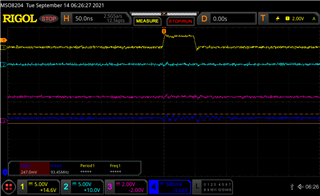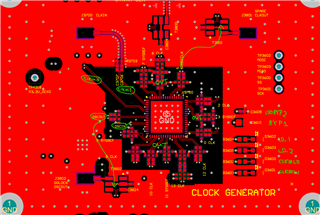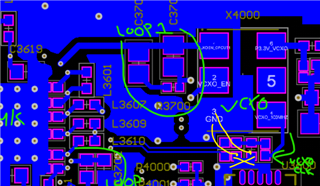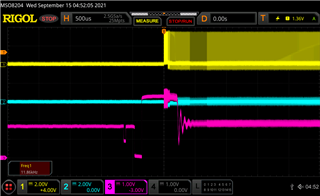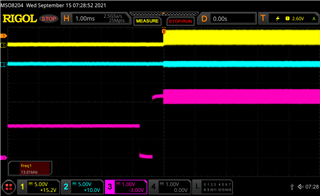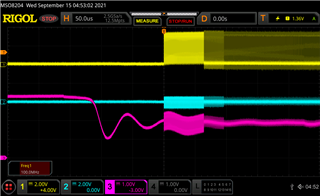Overview
Our LMK04828 design intermittently fails PLL1 initial lock at startup. We are able to reproduce this failure if the LMK is “pre-warmed” up to a package temp of about 36°C from the last power cycle. If we power it up and the LMK’s package temp is ambient 25°C, the LMK achieves PLL1 lock and never loses lock, even if the package heats beyond 36°C. In the failed lock condition, PLL1_DLD, CP1Out, and the digital IO oscillate at some multiple of MHz frequency. We are seeking support from a TI engineer as the behavior seems to be not defined in the datasheet, and have provided the circuit schematic, LMK register settings, and scope shots.
Schematic Design
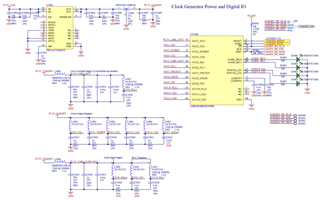

LMK Register Settings
CurrentSettings.txt
R0 (INIT) 0x000090
R0 0x000010
R2 0x000200
R3 0x000306
R4 0x0004D0
R5 0x00055B
R6 0x000600
R12 0x000C51
R13 0x000D04
R256 0x01007E
R257 0x010122
R258 0x010255
R259 0x010305
R260 0x010462
R261 0x010500
R262 0x0106B0
R263 0x010706
R264 0x010868
R265 0x010922
R266 0x010A55
R267 0x010B05
R268 0x010C62
R269 0x010D00
R270 0x010EB0
R271 0x010F16
R272 0x01107E
R273 0x011122
R274 0x011255
R275 0x011305
R276 0x011462
R277 0x011500
R278 0x0116B0
R279 0x011706
R280 0x011861
R281 0x011955
R282 0x011A55
R283 0x011B01
R284 0x011C22
R285 0x011D00
R286 0x011E70
R287 0x011F06
R288 0x01200A
R289 0x012155
R290 0x012255
R291 0x012300
R292 0x012422
R293 0x012500
R294 0x012670
R295 0x012711
R296 0x012868
R297 0x012922
R298 0x012A55
R299 0x012B05
R300 0x012C62
R301 0x012D00
R302 0x012EB0
R303 0x012F11
R304 0x01301E
R305 0x013122
R306 0x013255
R307 0x013305
R308 0x013442
R309 0x013500
R310 0x0136B0
R311 0x013761
R312 0x013830
R313 0x013903
R314 0x013A02
R315 0x013B80
R316 0x013C00
R317 0x013D08
R318 0x013E03
R319 0x013F00
R320 0x014000
R321 0x014100
R322 0x014200
R323 0x014311
R324 0x0144FF
R325 0x01457F
R326 0x014608
R327 0x01470E
R328 0x014813
R329 0x014913
R330 0x014A00
R331 0x014B05
R332 0x014CFF
R333 0x014D00
R334 0x014E00
R335 0x014F7F
R336 0x015000
R337 0x015102
R338 0x015200
R339 0x015300
R340 0x015401
R341 0x015500
R342 0x015601
R343 0x015700
R344 0x01580A
R345 0x015900
R346 0x015A0A
R347 0x015BDF
R348 0x015C20
R349 0x015D00
R350 0x015E00
R351 0x015F0B
R352 0x016000
R353 0x01610A
R354 0x016290
R355 0x016300
R356 0x016400
R357 0x016504
R369 0x0171AA
R370 0x017202
R380 0x017C15
R381 0x017D33
R358 0x016600
R359 0x016700
R360 0x01684B
R361 0x016949
R362 0x016A00
R363 0x016B20
R364 0x016C00
R365 0x016D00
R366 0x016E13
R371 0x017300
R386 0x018200
R387 0x018300
R388 0x018400
R389 0x018500
R392 0x018800
R393 0x018900
R394 0x018A00
R395 0x018B00
R8189 0x1FFD00
R8190 0x1FFE00
R8191 0x1FFF53
R0 (INIT) 0x000090 R0 0x000010 R2 0x000200 R3 0x000306 R4 0x0004D0 R5 0x00055B R6 0x000600 R12 0x000C51 R13 0x000D04 R256 0x01007E R257 0x010122 R258 0x010255 R259 0x010305 R260 0x010462 R261 0x010500 R262 0x0106B0 R263 0x010706 R264 0x010868 R265 0x010922 R266 0x010A55 R267 0x010B05 R268 0x010C62 R269 0x010D00 R270 0x010EB0 R271 0x010F16 R272 0x01107E R273 0x011122 R274 0x011255 R275 0x011305 R276 0x011462 R277 0x011500 R278 0x0116B0 R279 0x011706 R280 0x011861 R281 0x011955 R282 0x011A55 R283 0x011B01 R284 0x011C22 R285 0x011D00 R286 0x011E70 R287 0x011F06 R288 0x01200A R289 0x012155 R290 0x012255 R291 0x012300 R292 0x012422 R293 0x012500 R294 0x012670 R295 0x012711 R296 0x012868 R297 0x012922 R298 0x012A55 R299 0x012B05 R300 0x012C62 R301 0x012D00 R302 0x012EB0 R303 0x012F11 R304 0x01301E R305 0x013122 R306 0x013255 R307 0x013305 R308 0x013442 R309 0x013500 R310 0x0136B0 R311 0x013761 R312 0x013830 R313 0x013903 R314 0x013A02 R315 0x013B80 R316 0x013C00 R317 0x013D08 R318 0x013E03 R319 0x013F00 R320 0x014000 R321 0x014100 R322 0x014200 R323 0x014311 R324 0x0144FF R325 0x01457F R326 0x014608 R327 0x01470E R328 0x014813 R329 0x014913 R330 0x014A00 R331 0x014B05 R332 0x014CFF R333 0x014D00 R334 0x014E00 R335 0x014F7F R336 0x015000 R337 0x015102 R338 0x015200 R339 0x015300 R340 0x015401 R341 0x015500 R342 0x015601 R343 0x015700 R344 0x01580A R345 0x015900 R346 0x015A0A R347 0x015BDF R348 0x015C20 R349 0x015D00 R350 0x015E00 R351 0x015F0B R352 0x016000 R353 0x01610A R354 0x016290 R355 0x016300 R356 0x016400 R357 0x016504 R369 0x0171AA R370 0x017202 R380 0x017C15 R381 0x017D33 R358 0x016600 R359 0x016700 R360 0x01684B R361 0x016949 R362 0x016A00 R363 0x016B20 R364 0x016C00 R365 0x016D00 R366 0x016E13 R371 0x017300 R386 0x018200 R387 0x018300 R388 0x018400 R389 0x018500 R392 0x018800 R393 0x018900 R394 0x018A00 R395 0x018B00 R8189 0x1FFD00 R8190 0x1FFE00 R8191 0x1FFF53
Experiments
We started by determining the condition in which PLL1 goes unstable and does not lock. The failure seemed temperature dependent so we began by cooling IC’s with canned air in an attempt to find which IC is sensitive and where the threshold is. We found that when the LMK04828’s package starts above 36°C and the LMK is powered on, PLL1 will not lock. This test was repeated with a hot board and a small heat gun, warming the IC. Interestingly, if the LMK is powered on while it is cold it locks instantly and maintains lock well above 36°C.
When the LMK fails to lock, the Status_LD1 I/O assigned to the PLL1_DLD lock state oscillates at either 100MHz, 10MHz, 5MHz or other whole number divisions of 100MHz. With our PLL1_WND_SIZE set to 43ns and PLL1_DLD_CNT set to 8192 we don't believe the LD1 PLL1 lock output should be able to switch states at anywhere near these frequencies if the datasheet is correct. We worry that the LMK is entering an undefined state or a feedback loop, of which we have no clear solution. It feels pertinent to note that in this state the LMK’s digital outputs and inputs (SPI and LD1/LD2) have significant noise present at the same frequency when in the fault condition.
We have checked the LMK’s 3V3 supply, it is clean and provided by a local low noise LDO (TPS7A4701). The filtering into the VCC pins for the various supplies on the LMK are decoupled with appropriate capacitors and filtered with appropriate low series resistance ferrites. The decoupling scheme to our knowledge aligns with the recommendations in the datasheet. We additionally tried powering the VCXO from a different supply than the LMK’s supply and found the same behavior was present.
Our reference OCXO (±50ppb) is powered from another separate LDO supply and conforms to slew rate and voltage requirements. Our VCXO (±50ppm absolute pulling range) also conforms to slew and output voltage requirements. It has a max pulling range of 50ppm and in normal operation does not thermally drift more than 18ppm (calculated by differencing the hot and cold PLL1 control voltage as well as the ppm/V values).
We have attempted multiple loop filter R C configurations for bandwidths, 100hz, 1000hz, and 20khz (the schematic shows Loop Filter PLL1 for 100hz). All calculated with the PLLatinum Sim. The response of the PLL seems appropriately damped when it manages to lock, leading us to believe our loop filter is appropriately tuned.
We have disabled the reset input in an attempt to remove the possibility of it responding to noise and resetting the LMK. We have holdover disabled, PLL delays disabled, and no sync or clock source switching enabled. We tried lowering PLL1’s detect frequency from 10Mhz to 1Mhz with a divider change and found the same fault. We also tried powering down the entire DCLK/SDCLK output stage and found the same fault.
For all Scope Captures:
Trace 1 - LD1(PLL1 lock)
Trace 2 - LD2(PLL2 lock)
Trace 3 - PLL1 control voltage output
Capture of a successful lock with a room temperature board (RigolDS0.png)
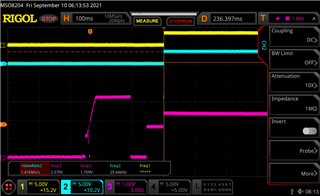
Failure to Lock (Control voltage drifts up to 3V3) (RigolDS18.png)
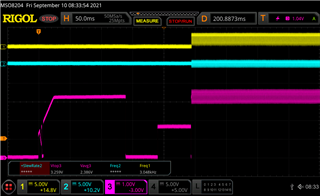
Failure to Lock (Control voltage drops to close to 0V) (RigolDS7.png)

Failure to lock (finer timescale) (RigolDS20.png)
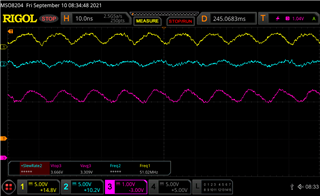


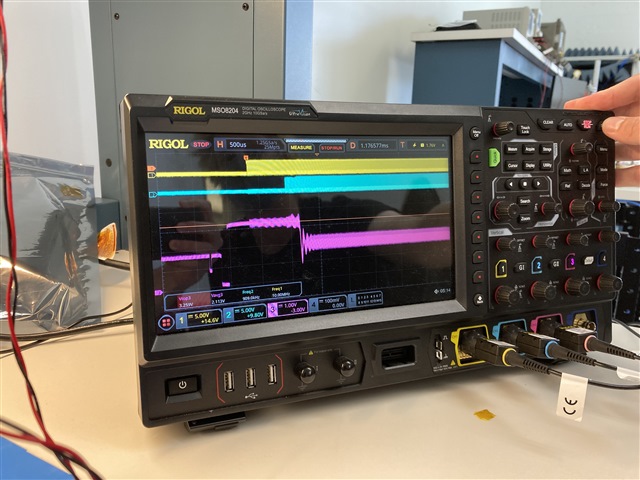
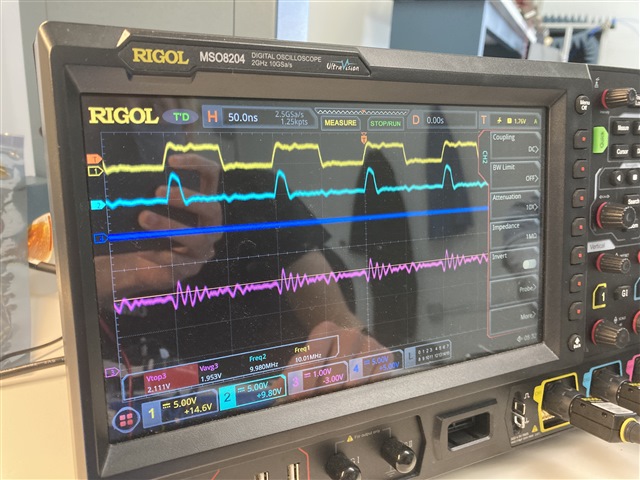
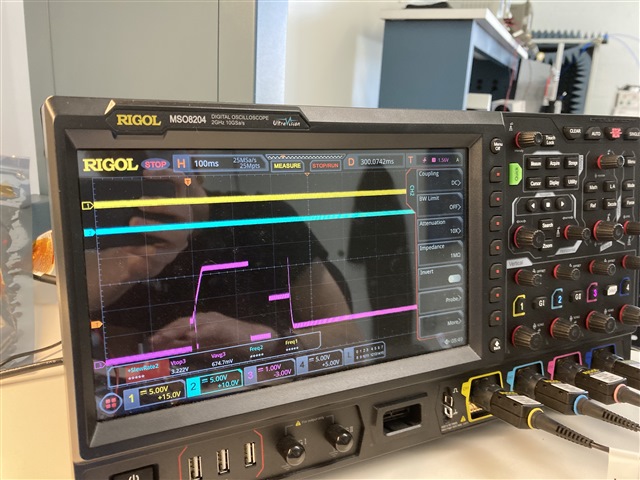

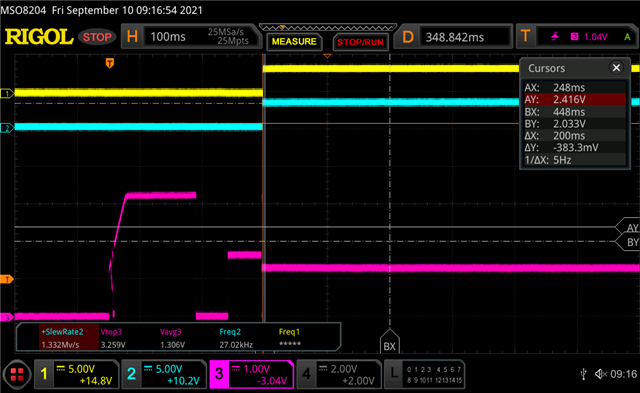
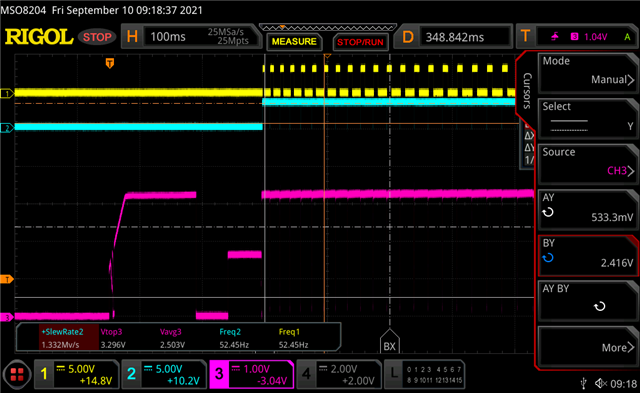

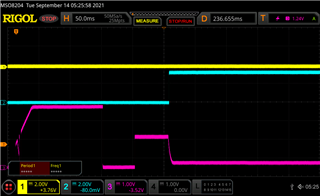


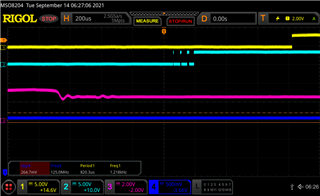 .
.